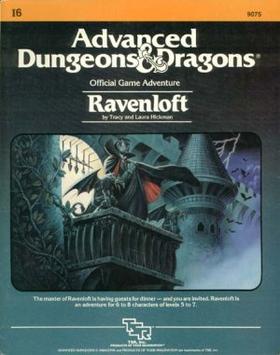In my A Game Per Year project, my goal has been to read one roleplaying game corebook for every year they’ve been published. However, I soon started to feel that it was hard to decipher how the games were really meant to be played. For this reason, I decided to start a parallel project, An Adventure Per Year, to read one roleplaying adventure for each year they’ve been published.

Ravenloft is a 1983 adventure by Tracy and Laura Hickman for AD&D. It casts a long shadow: It inspired the campaign setting of the same name and has recently been remade as the D&D 5th Edition adventure Curse of Strahd, which I also read recently. It’s villain, the vampire Strahd von Zarovich, is one of the best known characters in the expansive D&D canon.
The copy that I have features penciled-in notes from some unknown past owner, clearly made in the process of running the adventure. It’s fun to see these signs of the adventure being played.
The characters are invited to the land of Barovia where they encounter all the trappings of old-school horror movies set in archaic east European towns. Sullen locals, swirling mists and clouds that are always described as “boiling”. There’s an interesting design conceit where the DM can randomize some aspects of the adventure by performing a card reading that the game stresses does not resemble any real-world fortune telling process.
The characters can have the reading done for them in a gypsy camp. (The gypsy trope is present in the unreconstituted style of many American roleplaying games.) Thus, the randomizing of the adventure becomes an in-game event.
Most of the adventure takes place in Strahd’s castle, basically a big dungeon with gothic trappings like bats and crypts. There’s a story, with an innocent girl living in the village, terrorized by the vampire who thinks she looks like his dead love obsession. There’s even an end scene where Strahd’s good brother appears as a ghost to take the girl to happily ever after!
There are interesting tonal shifts in the adventure, especially close to the end when the characters are in Strahd’s crypt. In addition to werewolves and wights, they are presented with puns such as the tomb of “Stahbal Indi-Bhak”. The stylistic choice of combining gothic horror with dad jokes was preserved intact in the 5th Edition version of this adventure.
The original Ravenloft is 32 pages with gorgeous Clyde Caldwell illustrations, a great example of the visual flair that TSR gained at this time. The new Curse of Strahd adventure is much bigger, a big hardcover book presenting a small campaign setting complete with towns, adventure sites, ruins and all sorts of other stuff absent from the original. It’s an example of the 5th Edition “greatest hits” style where new adventures tend to update or call back to D&D’s past instead of trying to break new ground.
Ravenloft is best seen in the context of the D&D adventure design of its time. It’s themes of undying tragedy and romance set it apart from the sword and sorcery dungeon romps that formed much of the TSR oeuvre and Strahd is significantly more memorable as a bad guy than most of the villains of the age.